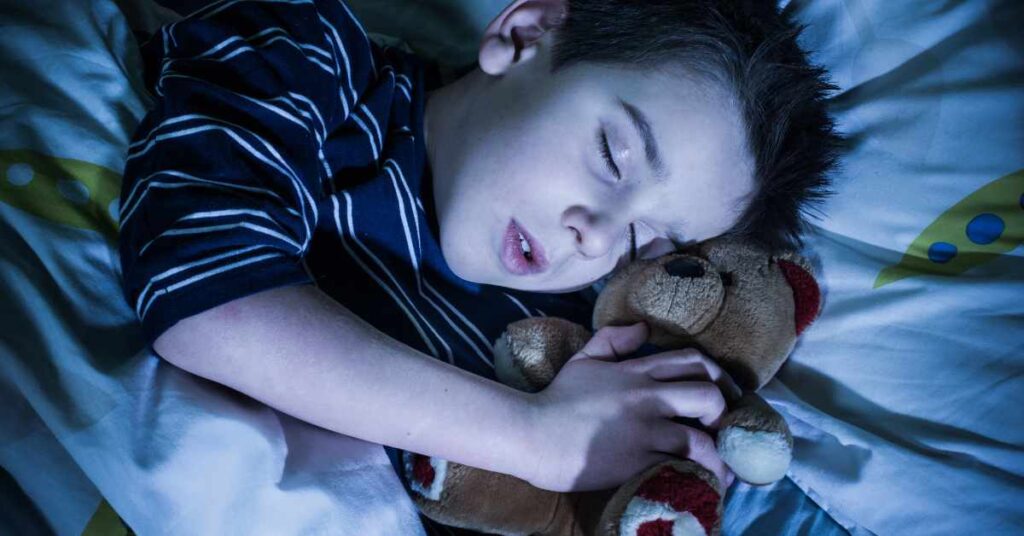Table of Contents
Why is sleep important for a child?

Sleep is critical for children’s overall health and development and plays a vital role in several key areas, including:
- Physical growth: During sleep, children’s bodies produce hormones that help with growth and development.
- Brain development: Sleep helps with the consolidation of memories and the formation of new neural connections, which is important for learning and cognitive development.
- Mood regulation: Sleep helps regulate emotions and can improve mood, reducing the risk of depression and anxiety in children.
- Immune system function: Sleep helps boost the immune system, reducing the risk of illness and infection.
- Behavior: Children who get enough sleep tend to have better behavior and are less likely to have behavioral problems.
- Learning and academic performance: Sleep helps with attention, focus, and memory, which are important for academic performance. Children who don’t get enough sleep may have difficulty concentrating and retaining information in school.
- Overall health: Lack of sleep has been linked to various health problems, including obesity, heart disease, and diabetes. Getting enough sleep helps to promote overall physical health.
In short, sleep is essential for children’s growth, development, and overall well-being. It’s important for parents to ensure that their children are getting enough sleep to support their healthy growth and development.
What are the requirements for sleeping behavior in children from birth to 6 years old?
The amount and quality of sleep that children need change as they grow and develop. Here are the general guidelines for sleep requirements for children from birth to 6 years old:
- Birth to 3 months: Most newborns sleep between 14 and 17 hours a day, with most of the sleep being in the form of short naps throughout the day and night.
- 4 to 11 months: At this age, most babies will sleep for about 12 to 15 hours a day, with about 10 to 11 hours being at night and the rest in naps.
- 1 to 2 years: Children at this age typically sleep 11 to 14 hours a day, with about 9 to 10 hours being at night and the rest in naps.
- 3 to 5 years: At this age, children typically sleep 10 to 13 hours a day, with about 10 to 11 hours being at night and the rest in naps.
- 6 years and up: Children at this age typically sleep 9 to 11 hours a day, with all of the sleep being at night.
It’s important to note that these are general guidelines, and every child is different.
Some children may need more or less sleep than these recommended amounts. Additionally, children’s sleep patterns may change temporarily due to growth spurts, illnesses, or environmental changes.
If you have concerns about your child’s sleep, it’s best to consult a pediatrician.
Sleep patterns of a newborn
Newborns have different sleep patterns and requirements compared to older children and adults.
Here are some key features of sleep for newborns:
Quality: Newborn sleep is characterized by light and deep sleep stages, with periods of active sleep that can include rapid eye movements, twitching, and crying. This type of sleep is important for brain development.
Quantity: Newborns typically sleep for 16 to 17 hours per day, but the sleep is broken into short periods of 2 to 4 hours at a time. Over the first few months, they will start to sleep for longer stretches of time.
Day-night confusion: Newborns may have difficulty distinguishing between day and night and may sleep equally well during both periods.
Sleep location: Newborns should sleep on their backs in a crib or bassinet that meets safety standards to reduce the risk of sudden infant death syndrome (SIDS).
Scheduling: Newborns may benefit from a flexible sleep schedule in the early months, but eventually a more structured routine can help regulate their internal clock.
It’s important for parents of newborns to understand these features of sleep and to create a safe and supportive sleep environment to help their children get the quality sleep they need for healthy growth and development.
Environment for children good sleep
Creating a sleep-conducive environment for children can help them get the quality sleep they need for healthy growth and development. Here are some tips for creating a good sleep environment for children.
Here are some steps that parents can take to help their child get better sleep:
- Set a consistent sleep schedule: Establish a regular bedtime and wake-up time to help regulate your child’s internal clock.
- Create a calming sleep environment: Keep the bedroom cool, dark, and quiet. Use curtains or blinds to block light and invest in a white noise machine to help drown out any background noise.
- Use a comfortable mattress: Make sure your child has a comfortable mattress and bedding that supports their growing body.
- Reduce screen time before bed: The blue light emitted from screens can interfere with sleep, so limit screen time to an hour or two before bedtime.
- Create a bedtime routine: It can help signal your child that it’s time to wind down and go to sleep. This can include activities like reading a book, taking a bath, or singing a lullaby.
- Avoid caffeine and sugary drinks: Caffeine and sugary drinks can interfere with sleep, so avoid giving them to your child before bedtime.
- Avoid stimulation before bed: Stimulating activities like playing video games, watching TV, or engaging in physical activity can make it harder for children to fall asleep, so avoid these activities before bedtime.
- Encourage physical activity: Encourage the child to be physically active during the day, as this can help improve sleep quality and reduce the risk of sleep disorders.
- Manage stress: Help the child manage stress and anxiety through relaxation techniques or therapy to promote better sleep.
By creating a sleep-conducive environment for children, parents can help ensure their children get the quality sleep they need for healthy growth and development.
Temperature and humidity in the room where a child sleeps
The temperature and humidity in the room where a child sleeps can greatly impact the quality of their sleep. Here are some guidelines to consider:
- Room temperature: The ideal room temperature for sleep is between 60°F and 67°F (15,5°C to 19,5°C). This temperature range helps to create a comfortable and cool environment that promotes sleep. If the room is too hot or too cold, it can interfere with sleep.
- Humidity: Maintaining the right level of humidity in the room can help prevent dryness and discomfort, which can affect sleep. A humidity level between 30% and 50% is ideal for sleep. If the air is too dry, a humidifier can help, while if it’s too humid, a dehumidifier can help.
It’s important to monitor the temperature and humidity in the child’s room and make adjustments as needed to maintain a comfortable sleep environment. If you have concerns about the temperature and humidity in your child’s room, you can consider using a smart thermostat or humidity monitor to track and adjust the conditions.
A good sleep environment can help ensure that children get the quality sleep they need for healthy growth and development.
Sleep disorders in children and how to deal with them
Sleep disorders can affect children of all ages and significantly impact their health, behavior, and development. Some common sleep disorders in children include:
- Insomnia: This is a condition in which a child has trouble falling asleep or staying asleep, resulting in insufficient sleep.
- Sleep apnea: This is a condition in which a child stops breathing temporarily during sleep, which can result in snoring, restless sleep, and excessive daytime sleepiness.
- Restless leg syndrome: This is a condition in which a child has an irresistible urge to move their legs, which can interfere with sleep.
- Nightmares and night terrors: Children may experience nightmares or night terrors, which can cause fear and anxiety and result in disrupted sleep.
To help manage sleep disorders in children, it’s important first to consult a pediatrician. They can help diagnose the specific disorder and develop an appropriate treatment plan.
Some strategies for dealing with sleep disorders in children include:
- Establishing a consistent sleep routine: A regular sleep schedule and bedtime routine can help regulate the child’s internal clock and promote better sleep.
- Creating a sleep-conducive environment: Maintaining the right temperature, humidity, and light levels in the child’s room can help create a calm and comfortable sleep environment.
- Limiting screen time: Reducing screen time before bed can help reduce stimulation and promote sleep.
- Encouraging physical activity: Regular physical activity can help improve sleep quality and reduce the risk of sleep disorders.
- Managing stress: Helping children to manage stress and anxiety through relaxation techniques or therapy can also improve sleep.
- Medications: A pediatrician may sometimes recommend medication to help manage sleep disorders.
It’s important to take sleep disorders in children seriously and seek help from a pediatrician to ensure that the child gets the treatment they need to improve their sleep and overall health.
CONCLUSION
Children grow up in their sleep
Growth hormone (somatotropic hormone) is primarily produced by the pituitary gland during deep sleep stages, with the highest levels typically occurring in the first half of the night. During deep sleep, GH secretion is increased, leading to increased growth and repair of tissues, as well as the regulation of metabolism and body composition.
It’s important to note that while GH secretion is highest at night, it is also produced in smaller amounts during the day in response to physical activity, stress, and other stimuli. The precise regulation of GH secretion is complex and involves the interplay of several factors, including age, sex, body composition, and circadian rhythm.
Overall, GH is an important hormone for growth and metabolism, and maintaining appropriate GH levels is critical for good health throughout life.
Ensuring adequate sleep and avoiding disruptions to the sleep-wake cycle can help to promote normal GH secretion and support good health and growth.
Are you interested in learning more about creating a healthy environment for your child? Don’t miss out on this valuable information – share this article with your friends and family and subscribe to our newsletter for more helpful insights on child health creation!





